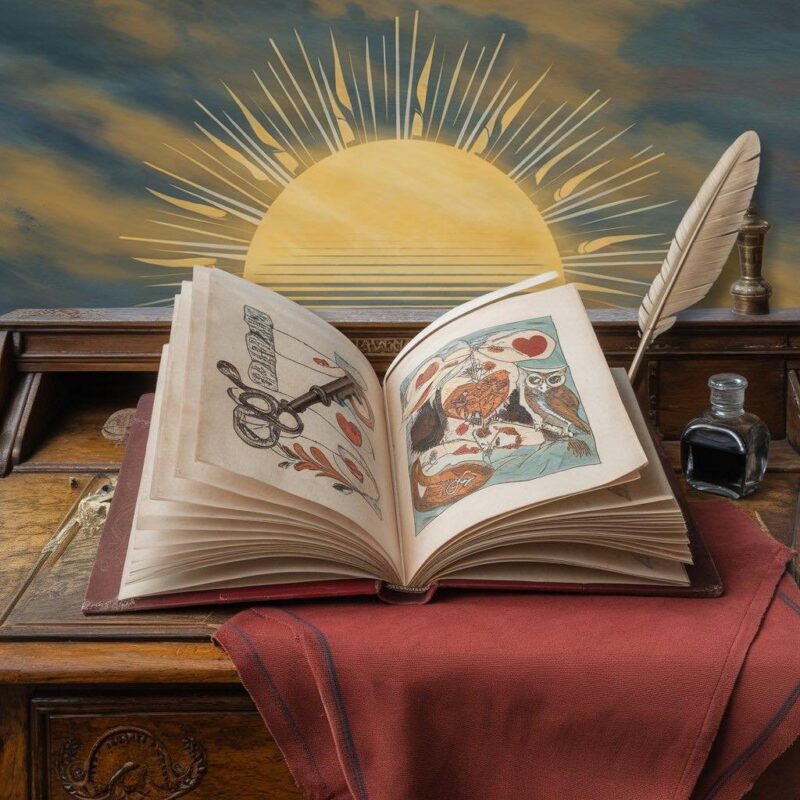- Indie authors are revolutionizing the literary world by self-publishing their works, bypassing traditional gatekeepers and maintaining full creative control. This approach allows them to explore niche markets and connect directly with readers.
- Self-publishing platforms like Amazon Kindle Direct Publishing have democratized the process, enabling a broader range of voices to be heard. Despite perceptions of lesser prestige, many indie authors thrive without traditional constraints, retaining higher royalties and creative freedom.
- Key strategies for indie authors include:
– Professional editing and proofreading: ensure book quality and credibility
– Cover design: create professional, genre-appropriate covers that attract readers
– Formatting for multiple platforms: ensure book compatibility across various reading devices
– Building an author platform: utilize social media, blogs, and newsletters to engage readers
– Utilizing beta readers: gather pre-publication feedback for revisions
– Effective pricing strategies: experiment with pricing to boost sales and reviews
– Leveraging Amazon’s algorithms: optimize for keywords and metadata for greater visibility
– Running promotions and giveaways: generate buzz and attract new readers
– Networking with other authors: provide mutual support and cross-promotion opportunities
– Continuous learning and adaptation: always stay updated on industry trends
– Audiobook production: expand reach through audio formats
– International markets: translate books to reach global audiences - Indie publishing’s flexibility allows authors to explore diverse genres and trends, from romance and mystery to fantasy and nonfiction, catering to niche audiences.
- Platforms like Amazon KDP, Barnes & Noble Press, and Kobo Writing Life offer varying royalty rates and distribution options, each suited to different market needs.
- Building an author brand and community through consistent engagement and collaboration is essential for long-term success.
Indie authors are making waves in the literary world by taking control of the entire publishing process themselves. An indie author is a writer who publishes their work without the help of an established press, handling everything from editing to marketing on their own. This independence allows for greater creative freedom and a direct connection with readers.
From gripping fiction to insightful nonfiction, the works of indie authors span across various genres and styles. Indie books often bring fresh perspectives and innovative storytelling that traditional publishing might overlook. Authors like Amanda Hocking have shown that leveraging social media can amplify their reach and build dedicated fanbases.
Self-publishing offers more control over the final product, making it an attractive option for many writers. The Alliance of Independent Authors and platforms like Reedsy provide support and resources, helping authors navigate the complexities of self-publishing. Readers interested in discovering unique and diverse voices should definitely explore the world of indie literature.
The Indie Author Landscape
Indie authors have revolutionized the literary world by utilizing self-publishing to bypass traditional publishing gatekeepers. This shift has allowed them to explore niche markets and maintain full creative control.
Understanding Indie Publishing
Indie publishing refers to authors who self-publish their work, avoiding traditional publishers. These authors handle everything from writing to marketing. This path offers complete creative control, allowing authors to choose their cover designs, set prices, and decide on distribution channels.
Self-publishing platforms like Amazon Kindle Direct Publishing have made it easier for writers to reach readers directly. The democratization of publishing tools means a larger variety of voices can be heard.
While some view indie publishing as less prestigious, many authors thrive without the constraints of traditional publishing norms.
Comparison to Traditional Publishing
Traditional publishing involves working with established publishing houses that handle editing, marketing, and distribution. Authors often seek validation from these publishers, viewing a book deal as a mark of success. However, this route can be limiting in terms of creative freedom and financial returns.
In contrast, self-published authors retain a higher percentage of royalties but must invest more time and resources in the business side of writing. Trade publishing offers wider distribution and potential media coverage, while indie authors build relationships directly with their readers.
| Aspect | Traditional Publishing | Indie Publishing |
|---|---|---|
| Creative Control | Limited | Full |
| Royalty Percentage | Lower | Higher |
| Marketing | Handled by publisher | Done by author |
| Distribution | Wide, often in physical stores | Mostly online |
The Rise of Self-Published Authors
Technological advances and changing reader preferences have fueled the rise of self-published authors. Platforms like Smashwords and Lulu offer tools for formatting and distributing books worldwide.
Many indie books cater to niche audiences, providing stories that might not fit into mainstream genres. This has led to a significant and dedicated fanbase for many indie authors.
Earning potential for self-published authors has also grown, with some earning a substantial income solely from their books. A 2023 BIADD study noted that indie authors’ income grew by 53% compared to those traditionally published, highlighting the financial viability of this path. The same study also noted that indie authors make up over 50% of Kindle’s Top 400 Books for 2023.
For readers, indie books offer fresh and diverse content, expanding their literary options.
Genres and Trends in Indie Publishing
Indie publishing is characterized by its diversity and flexibility, allowing authors to explore a wide range of genres and trends. This section highlights key genres—romance, mystery, fantasy, and nonfiction—and current trends involving audience engagement, publishing techniques, and market demands.
Romance and Its Subgenres
Romance thrives in the indie publishing world, especially contemporary romance, romantic suspense, and paranormal romance.
Contemporary romance reflects real-world issues and relationships, making it relatable. Romantic suspense combines love with thrilling plotlines, attracting readers who enjoy excitement alongside emotional connections.
Paranormal romance delves into love stories involving supernatural elements. This subgenre’s blend of fantasy and romance captivates those fascinated by the eerie and extraordinary. Serialized formats, strong character arcs, and dynamic plot twists enhance the appeal.
Mystery, Thriller, and Horror
Mystery and thriller genres have always captivated readers, and indie authors are innovating within these spaces with unique twists.
Mysteries often feature amateur sleuths or unconventional detectives. Psychological thrillers focus on the inner workings of characters’ minds, heightening suspense. Horror leans more into atmospheric storytelling and psychological fear than gore, exploring themes like the supernatural or dystopian.
Series are popular because they foster long-term engagement. Indie authors use cliffhangers and deep character development to sustain interest over multiple books. Data-driven strategies help to fine-tune plot elements.
Fantasy and Science Fiction
Fantasy and sci-fi genres offer vast creative freedom, making them popular among indie authors who can world-build without constraints.
Epic fantasy series feature complex worlds and in-depth lore. Indie authors often create serialized content that allows for extensive character and plot development. Urban fantasy merges the fantastical with modern settings, appealing to readers who enjoy seeing magic in familiar environments.
Science fiction examines futuristic tech and space exploration, pushing the boundaries of imagination. Themes like dystopian futures and post-apocalyptic scenarios are common, reflecting both hope and caution about technological advancements.
Exploring Nonfiction in the Indie Space
Nonfiction is gaining ground in indie publishing, with authors diving into a myriad of topics such as biography, history, self-help, and memoir.
Indie nonfiction emphasizes personal expertise and unique perspectives. Biographies and memoirs offer intimate insights into personal lives. History books written by indie authors often reveal lesser-known events or perspectives.
The demand for self-help books remains strong, focusing on personal growth, mental health, and career advice. Indie authors utilize direct marketing and social media platforms to reach niche audiences effectively. High-quality, professionally edited content is crucial in this genre to build credibility and trust with readers.
12 Proven Strategies of Successful Indie Authors
1. Professional Editing and Proofreading
One of the most critical steps in self-publishing is ensuring that the manuscript is polished and free from errors. Indie authors often invest in professional editing and proofreading services. This not only improves the quality of the book but also enhances its credibility and readability.
2. Cover Design
A compelling cover design can significantly impact a book’s marketability. Indie authors frequently hire professional designers to create eye-catching covers that reflect the genre and tone of their book. A well-designed cover can attract potential readers and set the book apart in a crowded market.
3. Formatting for Multiple Platforms
Self-published books need to be formatted correctly for various platforms, such as Kindle, Apple Books, and print-on-demand services like Amazon’s KDP Print. Indie authors often use specialized software or hire experts to ensure their book meets the technical requirements of each platform.
4. Building an Author Platform
An author platform is essential for marketing and connecting with readers. Indie authors often use social media, blogs, and email newsletters to build a following. Engaging with readers through these channels can help authors create a loyal fanbase that eagerly anticipates their next release.
5. Utilizing Beta Readers
Before final publication, many indie authors use beta readers to provide feedback on their manuscript. These early readers can offer valuable insights into plot holes, character development, and pacing. This feedback allows authors to make necessary revisions before the book goes live.
6. Effective Pricing Strategies
Pricing is a crucial aspect of self-publishing. Indie authors often experiment with different pricing strategies, such as offering their book for free or at a reduced price for a limited time to boost initial sales and reviews. Others employ tiered pricing, gradually raising the price as the book acquires popularity.
7. Leveraging Amazon’s Algorithms
Amazon’s algorithms play a significant role in a book’s visibility. Indie authors often use keywords, categories, and metadata effectively to optimize their book’s placement in search results. Additionally, garnering reviews and maintaining steady sales can help a book climb Amazon’s rankings.
8. Running Promotions and Giveaways
Promotions and giveaways can generate buzz and attract new readers. Indie authors might use platforms like BookBub, Goodreads, or their own social media channels to run these campaigns. Offering free copies in exchange for honest reviews is another common tactic.
9. Networking with Other Authors
Building relationships with other indie authors can provide mutual support and opportunities for cross-promotion. Joining writing groups, attending conferences, and participating in online forums can help authors share experiences, resources, and advice.
10. Continuous Learning and Adaptation
The self-publishing landscape is constantly evolving. Successful indie authors stay informed about industry trends, new marketing techniques, and changes in platform policies. Continuous learning and adaptation are key to long-term success in self-publishing.
11. Audiobook Production
With the growing popularity of audiobooks, many indie authors are now producing audio versions of their books. This can be done through platforms like ACX (Audiobook Creation Exchange), where authors can either narrate their own books or hire professional narrators.
12. International Markets
Indie authors are increasingly looking beyond their home markets. Translating books into other languages and using international distribution channels can open up new readerships and revenue streams.
Marketing and Distribution Strategies
Authors looking to market and distribute their work must focus on reaching the right audience, choosing the best platforms to sell their books, and building a strong personal brand and engaged community. Effective marketing and distribution leverage tools, creativity, and collaboration to maximize reach and impact.
Reaching the Target Audience
Identifying and reaching the target audience is crucial for indie authors. By understanding who the readers are, authors can tailor their marketing strategies to align with their interests and preferences. Email marketing and social media platforms like Instagram and X can help build an engaged reader base.
Email lists enable authors to send targeted messages directly to interested readers. Tools like Mailchimp or ConvertKit can automate and personalize these communications. Social media marketing should focus on creating engaging content such as book teasers, author interviews, and reader Q&A sessions.
Selling the Work: Platforms and Royalties
Choosing the right platforms to sell books can significantly impact an author’s income. Platforms such as Amazon Kindle Direct Publishing (KDP), Barnes & Noble Press, and Kobo Writing Life offer different royalty structures and distribution options.
Amazon KDP provides access to a global readership and gives authors up to 70% in royalties. Barnes & Noble Press also offers competitive royalties and excellent support for physical book sales. Kobo Writing Life is ideal for reaching international markets, particularly in Europe, and offers flexible pricing options.
Here’s a table comparing key aspects of these platforms:
| Platform | Royalty Rates | Best For |
|---|---|---|
| Amazon KDP | Up to 70% | Global reach |
| Barnes & Noble Press | 55-65% | Physical book sales |
| Kobo Writing Life | 45-70% | International readers |
Building an Author Brand and Community
An author brand distinguishes their work and helps build a loyal community. The brand should reflect the author’s voice, themes, and values, which can be consistently conveyed through their website, social media, and book covers. Author websites serve as a central hub for all promotional activities and should include a blog, newsletter signup, and links to all sales platforms.
Engaging with readers through virtual book clubs, live streams, and reading challenges strengthens the bond with the community. Collaboration with other authors for joint promotions and anthologies can further expand reach and integrate different creative perspectives.
Mental health is also important. Authors should balance marketing activities to avoid burnout and stay creative. Using tools and resources wisely can help maintain this balance.
Further Reading
Just Do It (Yourself): A History of Self-Publishing by Alan Scherstuhl, Publishers Weekly
17 Pros and Cons of Traditional Publishing vs. Self-Publishing by Rick Lauber, Writer’s Digest
The 13 Most Common Self-Publishing Mistakes to Avoid by Lauren Bailey, janefriedman.com
The Rise & Rise of the Indie Author: Self-Publishing Futures by Alliance of Independent Authors, YouTube




